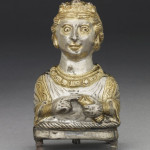Discovers Roman treasure
Lawes discovers the Hoxne hoard near the village of Hoxne in Suffolk, using a metal detector that his colleagues give him when he retired. While helping the farmer look for a lump hammer that had been dropped in a field near the village, he finds silver spoons, gold jewelry and numerous gold and silver coins. After retrieving a few items, he notifies the landowners and the police.
£1.75m reward
At the time, anyone who found and reported a treasure trove was rewarded with the cash equivalent of the market value of the treasure. The Treasure Trove Reviewing Committee values the hoard at £1.75 million which is paid to Lawes, who shares his reward with the farmer.
